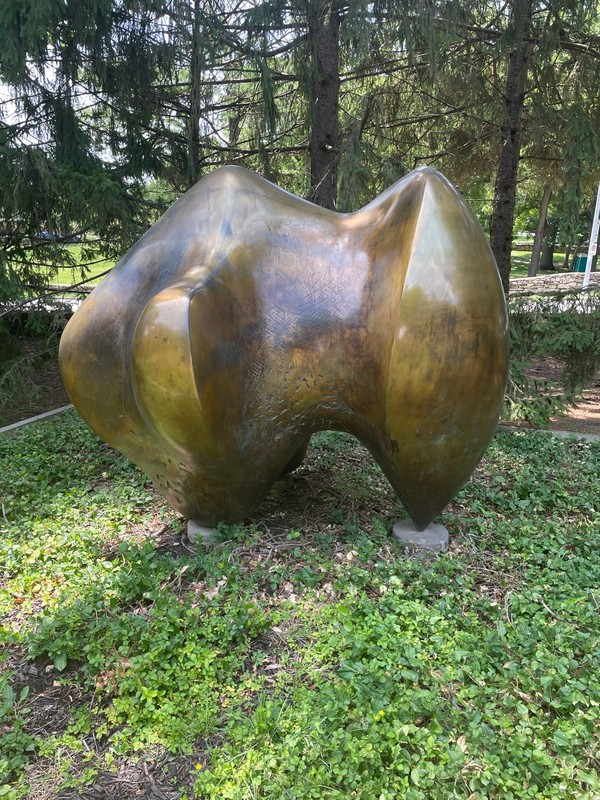Three Way Piece No. 1: Points
Introduction
Text-to-speech Audio
World renowned artist Henry Moore first concepted the six-foot bronze sculpture Three-Way Piece No. 1: Points in a three-inch plaster maquette. With much of Moore's creative influence stemming from a collection of natural objects found on the grounds of his estate in Hertfordshire, England, a pointed pebble fragment was the inspiration for Three-Way Piece No. 1: Points. Cast in 1964-65, the smooth, bulbous shape takes on an organic, biomorphic form while sharp edges and protrusions create asymmetry, provoking a tactile experience. In addition, Moore intentionally sculpted the form so that it could be rotated while on display to encourage multiple viewpoints, but the final piece was too large and heavy so it was placed resting on its three points.
Images
Three Way Piece No. 1: Points by Henry Moore

Henry Moore (1898-1986)

Backstory and Context
Text-to-speech Audio
Inspired by the shape of natural objects, Henry Moore would often collect miscellaneous findings from walks around his Hoglands estate, such as bones, flint and other stones, shells, and wood. He studied the composure and characteristics of the objects’ forms, as well as used them like tools to aid in shaping his molds. Moore describes his approach for this process:
“I look at them, handle them, see them from all round, and I may press them into clay and pour plaster into that clay and get a start as a bit of plaster, which is a reproduction of the object. And then add to it, change it. In that sort of way something turns out in the end that you could never have thought of the day before.”
Three-Way Piece No. 1: Points was inspired by “a pebble fragment with three points touching the ground” and the maquette was created using this technique. After the three-and-a-half inch maquette was complete, Moore used the form as the prototype for a larger piece, Working Model for Three-Way Piece No. 1: Points. He systematically measured the surface and points to calculate the proportion correctly to scale up in size, before building a wooden armature that would be used to create the plaster mold. This 25 inch plaster form then served as the model for Three-Way Piece No. 1: Points, which measures 6 feet and 4 inches tall. The sculpture at the Nelson-Atkins Museum of Art is the original cast (0/3) of an edition of 3 others in 1964-65.
Moore started increasing the size of his pieces in the 1960s, when he also experimented with the placement of holes and angles to achieve multiple viewpoints. He explains Three-Way Piece No. 1: Points was “an attempt to show one work from below as well as from on top and from the side. My idea was to make a new kind of sculpture, less dependent on gravity, which could be seen in at least three positions and be effective in all of them; a sculpture which you could understand more completely because you know it better. This worked in the maquette, but I made the finished bronze sculpture too large and heavy to be turned over by one person. We all make mistakes.”
Three-Way Piece No. 1: Points was gifted to The Nelson by the Hall Family Foundation.
Gallery Label
“Three-Way Piece No. 1: Points is named for the bulging forms that make up the mass of the sculpture and the three tapering points that support it. An abstract sculpture, it was inspired by the artist's abiding interest in stones and bones. Here, textural surfaces and colors alternate, ranging from smooth to deeply gouged, and from golden to rich brown.”
Sources
Gallery Label, Three-Way Piece No. 1: Points, The Nelson-Atkins Museum of Art. Accessed July 7th 2022. https://art.nelson-atkins.org/objects/31623/threeway-piece-no-1-points.
Alice Correia, ‘Working Model for Three Way Piece No.1: Points 1964, cast c.1964–9 by Henry Moore OM, CH’, catalogue entry, October 2013, in Henry Moore: Sculptural Process and Public Identity, Tate Research Publication, 2015, https://www.tate.org.uk/art/research-publications/henry-moore/henry-moore-om-ch-working-model-for-three-way-piece-no1-points-r1172004, accessed 08 September 2022.
Maquette for Three Way Piece No.1, Henry Moore Foundation. Accessed September 9th, 2022. https://catalogue.henry-moore.org/objects/14106/maquette-for-three-way-piece-no1.
https://www.bbc.co.uk/archive/henry-moore/znkkf4j
